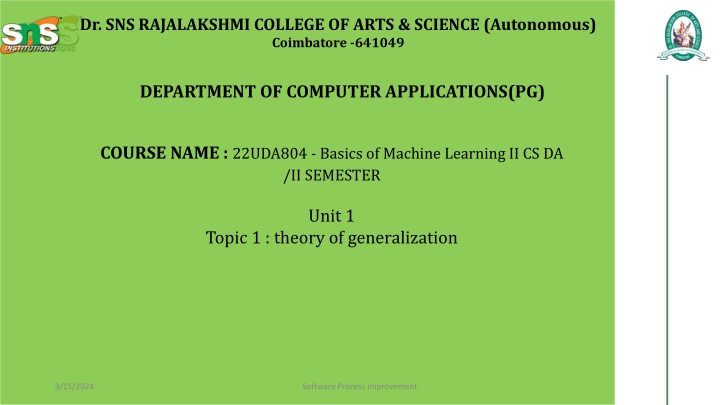
Theory of Generalization in Machine Learning
Theory of generalization in machine learning is essential for models to perform well on new data after training. It explores the concepts of overfitting, underfitting, bias-variance tradeoff, and more to ensure models can adapt effectively to unseen data.
Download Presentation

Please find below an Image/Link to download the presentation.
The content on the website is provided AS IS for your information and personal use only. It may not be sold, licensed, or shared on other websites without obtaining consent from the author. If you encounter any issues during the download, it is possible that the publisher has removed the file from their server.
You are allowed to download the files provided on this website for personal or commercial use, subject to the condition that they are used lawfully. All files are the property of their respective owners.
The content on the website is provided AS IS for your information and personal use only. It may not be sold, licensed, or shared on other websites without obtaining consent from the author.
E N D
Presentation Transcript
Dr. SNS RAJALAKSHMI COLLEGE OF ARTS & SCIENCE (Autonomous) Coimbatore -641049 DEPARTMENT OF COMPUTER APPLICATIONS(PG) COURSE NAME : 22UDA804 - Basics of Machine Learning II CS DA /II SEMESTER Unit 1 Topic 1 : theory of generalization 3/15/2024 Software Process Improvement
theory of generalization Theory of Generalization in Machine Learning Generalization is one of the core concepts in machine learning and refers to the model s ability to perform well on new, unseen data, after being trained on a specific dataset. In simple terms, generalization is the ability of a machine learning model to adapt its learned patterns to new situations that it hasn t encountered before. A well-generalized model predicts accurately on the test data, not just the training data. The theory of generalization addresses why some models generalize well and others do not, and how we can build models that are capable of performing well on unseen data. grouping and grading
theory of generalization 1. The Generalization Problem The primary goal of machine learning is to create models that perform well on test data (unseen data). However, a key challenge arises when the model performs very well on training data but poorly on test data. This is a classic sign of overfitting, where the model memorizes the training data rather than learning general patterns. The generalization problem in machine learning is essentially about balancing the tradeoff between fitting the training data well and avoiding overfitting. grouping and grading
theory of generalization 2. Overfitting vs. Underfitting Overfitting: A model that fits the training data too well, capturing noise and unnecessary patterns. Overfitting results in low training error but high test error, as the model fails to generalize to new data. Symptoms: Low training error, high test error, overly complex model. Cause: Model has too many parameters (e.g., high-degree polynomial in regression, deep neural networks with too many layers), or insufficient regularization. Underfitting: A model that is too simple to capture the underlying patterns of the data. Underfitting results in high training error and high test error. grouping and grading
theory of generalization 3. The Bias-Variance Tradeoff The bias-variance tradeoff is a fundamental concept that explains the generalization process in machine learning: Bias: Bias refers to the error introduced by simplifying assumptions in the model. High bias means that the model is too simple and underfits the data. Variance: Variance refers to the model s sensitivity to small fluctuations in the training data. High variance means the model is too complex and overfits the data. grouping and grading
theory of generalization Graphical Representation: High bias, low variance: Model underfits (simple model). Low bias, high variance: Model overfits (complex model). Low bias, low variance: Model generalizes well. grouping and grading
